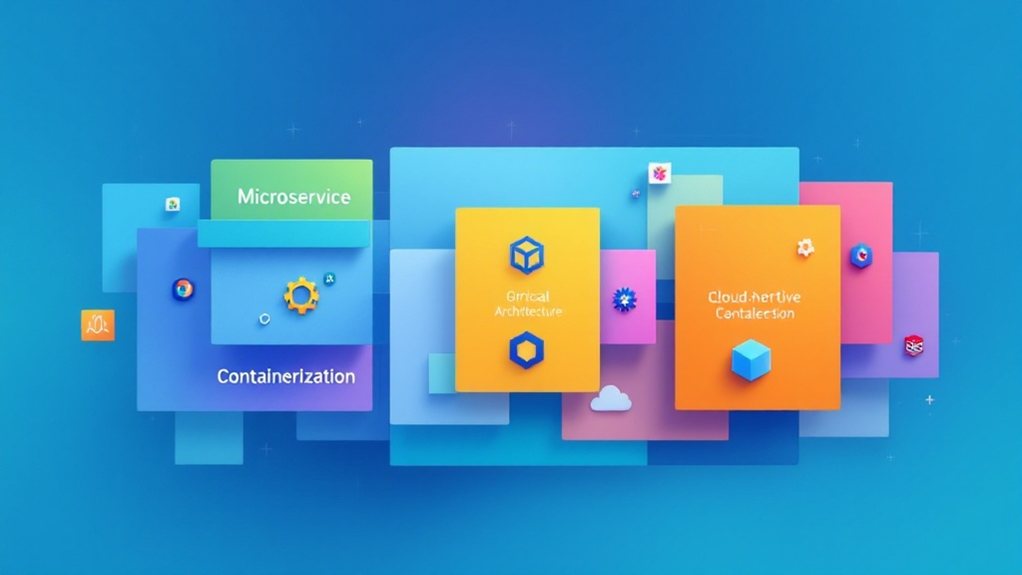Embrace modular architecture to promote flexibility and scalability. Implement caching strategies to reduce server load and improve response times. Leverage asynchronous processing to maintain a responsive user experience. Optimize performance by serving static assets from a CDN and utilizing lazy loading. Adopt microservices and containerization for increased resilience and the ability to update components individually. Pair these tips with a scalable database solution and robust monitoring to ensure your enterprise-focused web solutions can handle rising traffic and evolving business needs. Dive deeper to discover how these techniques can transform your web infrastructure.
Key Takeaways
- Implement a modular architecture to enhance flexibility, maintainability, and scalability, enabling parallel development and seamless component upgrades.
- Leverage caching strategies, including browser caching, server-side caching, and CDNs, to reduce server load and improve response times.
- Offload long-running or resource-intensive tasks to asynchronous processes, maintaining a responsive user experience and preventing application bottlenecks.
- Optimize performance by employing techniques such as caching, CDN utilization, image and asset optimization, and lazy loading.
- Adopt a microservices-based architecture with containerization to increase flexibility, scalability, and resilience, enabling individual component updates with reduced downtime.
Embrace Modular Architecture

The key to building scalable enterprise-focused web solutions lies in embracing a modular architecture. By breaking your application into smaller, independent components, you can develop, test, and deploy them individually. This approach promotes flexibility, maintainability, and scalability. Modular design allows you to swap out or upgrade specific parts of your system without disrupting the entire application. Additionally, it enables parallel development, where teams can work on different modules simultaneously, accelerating your time-to-market. Embrace a component-based structure, leveraging microservices or a service-oriented architecture, to create a scalable, adaptable enterprise web solution that can evolve with your business needs.
Implement Caching Strategies
Implementing robust caching strategies is paramount to achieving scalability in your enterprise-focused web solutions. Caching allows you to store frequently accessed data, reducing the load on your servers and improving response times. Leverage browser caching to cache static assets like images, CSS, and JavaScript files. Implement server-side caching for dynamic content, using in-memory caches like Redis or Memcached. Leverage content delivery networks (CDNs) to cache and serve content from geographically distributed servers. Regularly review and optimize your caching strategies as your application evolves. Caching is a powerful technique, but it requires careful planning and monitoring to ensure it aligns with your performance and scalability goals.
Leverage Asynchronous Processing

To handle long-running or resource-intensive tasks, you should leverage asynchronous processing. By offloading these tasks to a separate, asynchronous process, you can maintain a responsive user experience and prevent your web application from becoming bogged down. Asynchronous processing allows you to break down complex operations into smaller, manageable steps that can be executed independently. This approach not only improves performance but also enhances scalability, as the asynchronous processes can be distributed across multiple servers or worker nodes. By embracing asynchronous processing, you can build more efficient and resilient enterprise-focused web solutions that can handle increased traffic and workloads seamlessly.
Optimize for Performance
Optimizing performance is crucial for enterprise-focused web solutions. Leverage caching techniques to reduce server load and improve response times. Minimize network latency by serving static assets from a content delivery network. Optimize images, scripts, and stylesheets to reduce page load times. Implement lazy loading to defer the loading of non-critical resources until they're needed. Utilize asynchronous processing for time-consuming tasks, offloading them to background workers. Monitor your application's performance closely and address bottlenecks promptly. Continuously optimize and refine your codebase to maintain peak efficiency. Remember, enterprise users expect lightning-fast experiences, so make performance a top priority.
Embrace Microservices and Containerization

The adoption of microservices and containerization is a game-changer for enterprise-focused web solutions. By breaking down your application into smaller, independent services, you can enjoy increased flexibility, scalability, and resilience. Microservices allow you to update and deploy components individually, reducing the risk of downtime and making it easier to experiment with new features. Containerization, on the other hand, ensures consistent and reliable runtime environments, simplifying deployment and facilitating collaboration across teams. Embrace these transformative approaches to boost your web solution's performance, maintainability, and responsiveness to changing business needs. Leverage the power of microservices and containers to future-proof your enterprise-focused web development strategy.
Adopt a Scalable Database Solution
While microservices and containerization have revolutionized the way you approach enterprise-focused web solutions, you can't forget the importance of a scalable database solution. Opt for a cloud-based database that can automatically scale up or down based on your application's needs. This ensures your database can handle sudden spikes in traffic without sacrificing performance. Consider a managed database service like Amazon RDS or Azure SQL Database, which handle infrastructure management and scalability for you. Additionally, leverage sharding and partitioning techniques to distribute your data across multiple servers, improving read/write performance and availability. By adopting a scalable database solution, you'll futureproof your enterprise web application against growth and changing demands.
Incorporate Monitoring and Observability

As you scale your enterprise-focused web solutions, incorporating robust monitoring and observability practices is crucial. By implementing comprehensive monitoring, you can gain valuable insights into your application's performance, resource utilization, and potential issues. Leverage tools like application performance monitoring (APM) and infrastructure monitoring to track key metrics, identify bottlenecks, and proactively address problems. Incorporate observability techniques, such as distributed tracing and logging, to understand the end-to-end behavior of your application, from the user's perspective to the underlying infrastructure. With effective monitoring and observability, you can ensure your web solutions remain highly available, responsive, and scalable, even as your enterprise demands increase.

